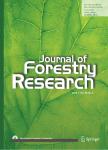Structure and floristic composition of tree stand in tropical forest in the Eastern Ghats of northern Andhra Pradesh, India
Structure and floristic composition of tree stand in tropical forest in the Eastern Ghats of northern Andhra Pradesh, India作者机构:Forestry and Ecology Division National Remote Sensing Centre Indian Space Research Organization Hyderabad - 500 625 Andhra Pradesh India. MENRIS Division International Centre for Integrated Mountain Develop- ment Kathmandu Nepal Salim Ali Centre for Ornithology & Natural History Deccan Regional Sta- tion 12-13-588/B Nagarjuna Nagar Colony Tarnaka Hyderabad-500 017Andhra Pradesh India.
出 版 物:《Journal of Forestry Research》 (林业研究(英文版))
年 卷 期:2011年第22卷第4期
页 面:491-500页
核心收录:
主 题:altitude conservation diversity Eastern Ghats speciescomposition
摘 要:The changes in species composition, abundance and forest stand structure were analyzed across altitudinal regimes in tropical forests of Eastern Ghats of northern Andhra Pradesh, India. Three 1-ha plots were established with one each in low, medium and high altitudes. A total of 153 species, 2129 stems (709 stems .ha^-1) of ≥10 cm girth were enumerated. Species richness and diversity pattern varied along altitudinal gradient and increased with the altitude. Species richness varied from 52 to 110 species-ha^-1 and stand density from 639 to 836 ***^-1 with average basal area of 34.39 m^***^-1. Shannon-Wiener index (H') ranged from 4.55 to 5.17. Low altitude (i.e., Site 1) is dominated byXylia xylocarpa (59.22) and Lagerstroemia parviflora (23.90), medium altitude (i.e., Site 2) by Xylia xylocarpa (45;50) Bursera serrata (17.29), and high altitude (i.e., Site 3) has Schleichera oleosa (28.25) Pterocarpus marsupium (26.55) as predominant species. Taxonomically, Rubiaceae (12 species), Fabaceae (12), Euphorbiaceae (11), Rutaceae (7) and Lanraceae (7) were dominant families. Density-wise, Fabaceae, Combretaceae, Euphorbiaceae, Anacardiaceae and Myrtaceae were abundant. Thus, conservation assessment based on altitudinal regimes and the information on species structure and function can provide baseline information for monitoring and sustaining the biodiversity.



